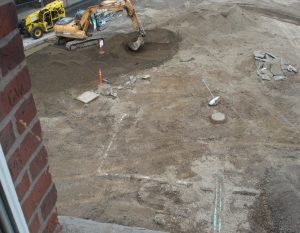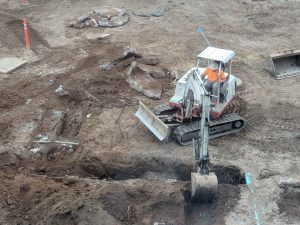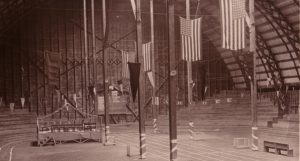
At the completion of Dundon-Berchtold Hall landscaping is one of the final phases, squaring off the green-space-quad joining Dundon-Berchtold, Romanaggi, Swindells, and Waldschmidt Halls. While scraping away gravel and going some inches below the top layer of grass and soil when dressing what has been the construction-workers’ staging site, the excavators excavated an unexpected find. An archaeological puzzle. The machines uncovered a tracery of foundation-walls, disclosing the remains of a structure outlined in the field north of Waldschmidt Hall.

A slight embarrassment and inconvenience when the University had not warned the workers against the presence of buried concrete. But gosh, a great question, because no one was aware that there had ever been a structure there.
A detective story! To the Archives! The excavators had uncovered a piece of UP sports culture; the cement and stone remains of a locker room out-building, fitted out to complement our show-piece all-weather out-door roof-covered-state-of-the-art Track & Field facility (1903). The changing room and shower was heated, too!
And the Solution? Starting with only the location, we turn for clues to the database list: Buildings, Past, Present & Demolished. Searching there for any conjectural entries; for example, The Bath House, a generic name with no given location and obelized (uncertain) dates, but the listing nestled among the early buildings. Provisionally pairing an unknown ruin with an unspecified building name, and a hint for possible further investigation.
Next, seek witnesses. There were four pioneer Holy Cross Religious, including the first Holy Cross president, Father Michael A. Quinlan, C.S.C. (1902-1906), who arrived here in 1902. Among them, Brother Wilfred Schreiber, C.S.C.- our most valuable witness– who served here the longest (1902-1933) and whose care was maintenance, fire-stoker, gardener, campus security officer and fixer, and a ministry cheering students. [Pioneer Four]

Bro. Wilfred recorded this ‘clue’ via a 1944 oral history project: “The old bath house was built by Fr. Quinlan at the time the Colosseum was built and it served as a shower room and dressing room for the athletes; also a lavatory for the students. It was built about half-way between the Main Building and the Colosseum.” (When the new gymnasium was finished it became a shop and was not moved from there until about 1937. Then all the shops and out buildings were transferred down below the steam plant. Ed’s note.) **
From Bro. Wilfred’s account we now have a name, function, and approximate date and location. The next step is the search for contemporary documentary evidence. Such as are found in the School Notes printed in the early campus publication, The Columbiad. This blurb from 1906 provides a precise beginning date, and, by giving the dimensions, adds a specific, checkable data-point:
The new bath house has been nearly completed. When finished it will afford the students splendid accommodations for dressing rooms, lockers and shower baths, which occupy a floor space 14 x 58 feet. The whole structure is much larger, containing in addition to what has been mentioned above two apartments for toilets and a room for the hot water plant. If the weather permits, the work should be completed by the first of March. By that time the old bath room will be converted into a carpenter shop. The Columbiad, Feb. 1906, p. 77.
The work was completed on-schedule in March, and heat was added to the out-building in 1909. The circumstantial case for identification complete. Probably.
The last question is the date of demolition. The only notice about the removal of buildings and the realignment of sidewalks and paths in the area behind West (Waldschmidt) Hall is found the The Beacon of September 19, 1936, prior to the opening of a new academic building. The student newspaper gives a progress report on campus changes, telling how during the summer two structures and several trees were removed in order to create a green-space of lawn between West, Howard, and the new Science (Romanaggi) Halls.
QED. The Bath House, March 1906-Summer 1936. Name, function, location, and dates. Probably. The ruin certainly of the building shown here, which is incidentally included (bottom-left) in this image of West (Waldschmidt) and Christie Halls (reproduced in The Columbiad, June 1926).

**Recollections of Columbia University of Portland Oregon; preserved and edited, Rev. Michael Early, C.S.C., (1944, p. 44), thanks also to those who organized and compiled the databases consulted: Bro. David Martin,C.S.C., first UP Archivist; Frs. Barry Hagan, C.S.C. and Robert Antonelli, C.S.C.; and Cora Miller and Martha Wachsmuth, long-time Archives associates. Fr. Early’s credentials for editing the Recollections are impeccable, he was himself a graduate of Columbia University (High School) in 1912, and before 1944 he had served as Vice President and President of Columbia U. 1933-36, 1935-1940, respectively. So, a qualified witness in his own right.
Additional Resources
1914 Aerial Campus
Congratulations on this discovery and the wisdom to preserve what should be preserved and to adapt it to current and future needs for the University.
The University has been on my mind for some time and a small donation will be sent this week.
I am grateful to the University of Portland (Holy Cross) for recognizing our credits from the Wasatch, Salt Lake City, Utah back in 1964. (My diploma is from the University of Portland, though I have not spent class time there.) I am grateful for any success and blessing from the University.